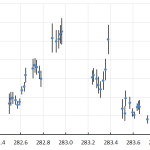By Jonas Schenker and Beat Booz
A fireball with a trajectory of over 150 km has been registered by video cameras of the Swiss Fachgruppe Meteorastronomie as well as by FRIPON stations. The event did not match the orbital elements of any known shower and was classified as sporadic.
1 Introduction
A fast fireball appeared over Northern Italy and ended above Switzerland after travelling over 150 km through the atmosphere. The event escaped from public attention as it appeared at 3h local time in the night. Cameras of the Swiss Fachgruppe Meteorastronomie and the French and Italian FRIPON cameras captured the fireball.
2 The available data
Clear sky allowed a good coverage of the event from many camera stations. Apart from video registrations radio meteor observers detected the echo reflection. The fireball was peculiar because of its speed and long trail and not so much for its brightness which barely reached –4 (Figure 1, 2 and 3). Although a moderate brightness many FRIPON stations registered the fireball allowing to calculate a very accurate orbit.

Figure 1 – The 2019 February 22, 02h07m34s UT fireball as captured on LOC5 (West) at Locarno, Switzerland.

Figure 2 – The 2019 February 22, 02h07m34s UT fireball as captured on LOC4 (SouthWest) at Locarno, Switzerland.

Figure 3 – The 2019 February 22, 02h07m34s UT fireball as captured Saint-Luc, France, by FRIPON (François Colas).
List of FRIPON stations that captured this fireball (Figure 4):
- Sormano (22/02/2019 02:07:15 UTC)
- Aurillac (22/02/2019 02:07:16 UTC)
- Dijon (22/02/2019 02:07:16 UTC)
- Alessandria (22/02/2019 02:07:15 UTC)
- Lyon (22/02/2019 02:07:15 UTC)
- Grenoble (22/02/2019 02:07:15 UTC)
- Saintluc (22/02/2019 02:07:15 UTC)
- Barolo (22/02/2019 02:07:15 UTC)
- Au busson (22/02/2019 02:07:16 UTC)
- OHP (22/02/2019 02:07:15 UTC)
- Aubenas (22/02/2019 02:07:16 UTC)
- Chalon (22/02/2019 02:07:15 UTC)
- Moulins (22/02/2019 02:07:16 UTC)
- Lusernasangiovanni (22/02/2019 02:07:15 UTC)
- Cuneo (22/02/2019 02:07:15 UTC)
- Saintlupicin (22/02/2019 02:07:15 UTC)
- Pontarlier (22/02/2019 02:07:15 UTC)
- Lignan (22/02/2019 02:07:15 UTC)
- Lesangles (22/02/2019 02:07:16 UTC)
- Beaumontlesvalence (22/02/2019 02:07:16 UTC)
- Bedonia (22/02/2019 02:07:15 UTC)
- Sutrieu (22/02/2019 02:07:15 UTC)
- Roanne (22/02/2019 02:07:16 UTC)

Figure 4 – The FRIPON stations that captured this fireball are marked in green.
3 The atmospheric trajectory
This fireball got in the atmosphere at an entrance angle of barely 10°. The exceptional high velocity of 64 km/s suffered rather little deceleration. The event happened between 128 km and 74 km of elevation. The beginning height is exceptional high.

Figure 5 – The trajectory of the 2019 February 22, 02h07m34s UT fireball as calculated from the FMA data.

Figure 6 – The trajectory of the 2019 February 22, 02h07m34s UT fireball as calculated from the FMA data.

Figure 7 – The trajectory of the 2019 February 22, 02h07m34s UT fireball as calculated from the FRIPON data (François Colas).
4 The orbit
The orbit calculation of the FMA data resulted in a slightly hyperbolic orbit, which may be explained because of the error margin on the velocity measurement. The FRIPON orbit has an eccentricity e just less than 1. The results are compared in Table 1. The fireball was most likely caused by a cometary fragment.
The geocentric radiant based on the FMA data resulted in αg = 202.9° and δg = –31.3° with a geocentric velocity vg = 63.2 km/s. There is not any known meteor shower from the IAU Meteor shower list that matches with the orbit of this fireball and therefore it can be classified as a sporadic.
Table 1 – The orbital elements obtained by FMA compared to the result obtained by FRIPON.
| FMA | FRIPON | |
| a | – | 87.4 AU |
| q | 0.552 AU | 0.5513 AU |
| e | 1.0004 | 0.9937 |
| ω | 83.32° | 83.58° |
| Ω | 152.89° | 152.89° |
| i | 131.97° | 131.95° |
Acknowledgment
The authors thank the FRIPON camera network for their data. The FMA results are based on the data of the following camera operators:
- Stefano Sposetti, Swiss Fachgruppe Meteorastronomie (FMA), Osservatorio Astronomico di Gnosca (GNO) and Locarno (LOC).
- Thomas K. Friedli, Swiss Fachgruppe Meteorastronomie (FMA), Observatory Sonnenturm Uecht.
- Roger Spinner, Swiss Fachgruppe Meteorastronomie (FMA), Observatoire géophysique Val Terbi (VTE).
- Jochen Richert, Swiss Fachgruppe Meteorastronomie (FMA), Observing station Bos-cha (BOS).
- Peter Kocher, Swiss Fachgruppe Meteorastronomie (FMA), Observing station Tentlingen (TEN).


